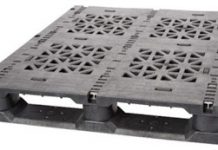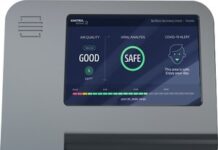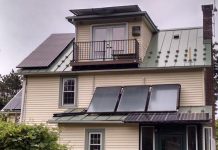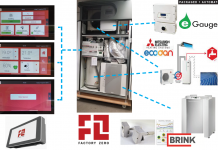David Gold
While many cleantech companies require very large amounts of capital in order to get to market, there is a quiet group of cleantech companies bucking that trend. Companies like Heartland Biocomposites (Green Building Materials), RealTech (Water Testing) and TerraLUX (LED Lighting) all built significant and growing businesses with compelling intellectual property and did so initially without multi-millions in capital from venture funds (let alone tens or hundreds of millions). Because TerraLUX is one of our portfolio companies and I therefore know them best, their story is one I am able to share.
TerraLUX boasts customers like Cooper Lighting, Phillips (PHG), GE Healthcare (GE), Snap-On Tools and many others. It has six awarded patents and eight more filed. Dr. Anthony Catalano founded the company in 2003 and, with exceptional technology smarts, creative boot-strapping and some of his own capital, he built a business with significant revenues, exciting gross margins and deep intellectual property – all without a penny of outside investment capital. And now, only after all those accomplishments, has TerraLUX closed a $5.6M financing from Emerald Technology Ventures and Access Venture Partners.
How did TerraLUX pull this off? The story starts with an entrepreneur focused first and foremost on how to create revenues. Catalano, who has a PhD from Brown in physical chemistry and is a previous director of the NREL Photovoltaic (solar cell) Division, had the technical acumen to create a business in a number of cleantech sectors but he wisely chose the LED market. He did so because he saw the industry’s explosive growth. His dream was to create LED lighting for buildings that could have a disruptive impact on lighting energy consumption. But Catalano realized he couldn’t just create a science project; he had to be able to sell innovative products quickly to create cash flow.
Seeing that in 2003 the cost/benefits of LED’s were not yet compelling for the large general lighting market he knew he had to turn to a more ready market – portable lighting. While this market is an order of magnitude smaller than general lighting, it is still a multi-billion dollar market and, most importantly, the benefits of higher brightness, extended lifetime and increased durability have premium value for users of products like flashlights, work lights and surgical lights. The portable lighting market was (and is) willing to pay a premium for those benefits and, as a result, even with the high cost of LED chips in 2003, TerraLUX was able to create real products and real customers.
I suspect some entrepreneurs would have turned up their noses at the thought of launching a flashlight business when their goal was the much bigger general lighting market. But Catalano didn’t let his ego get in the way of doing what was needed to do to get the business off the ground. Instead, he went to market with LED drop-in replacements for existing flashlight bulbs and was soon off and running. From there the company grew into multiple portable lighting product lines and well beyond just flashlights. As it turned out, creating high-performing portable LED products is, in many ways, more challenging than designing for general lighting. Limited space, challenging heat sink options, and a non-constant power source (e.g. batteries) create a plethora of challenges. But Catalano together with his VP-engineering, Dan Harrison (brilliant Caltech guy), used their considerable technical talent to create innovations to solve these problems. The result has been the creation of a deep intellectual property portfolio around temperature control, optics and circuitry, and the ability of TerraLUX to deliver LED products with unparalleled performance.
Success begets success, and TerraLUX’s flashlight products created awareness in the market. A few years later, TerraLUX’s phone began ringing with calls from other portable lighting manufacturing companies desiring to create LED versions of their lighting products. These companies needed something they could plug or screw into their existing products to turn them into high-performing LED versions. TerraLUX was one of the few companies that could deliver such results, and virtually no competitors could do so with the brightness, lifetime and light quality that they were able to achieve. The company responded to this market demand by leveraging its core intellectual property to create LED Embedded Light Modules (self-contained modules that can be screwed or plugged into other manufacturers’ products) on an OEM basis for manufacturers of a variety of portable lighting products.
As the years progressed, LED chip prices compared to their performance continued to drop rapidly and began to open up the potential in the general lighting market. TerraLUX then got the call it had wanted for years. A key executive at a large general lighting company had bought a TerraLUX flashlight retrofit kit and was impressed with its performance and extremely compact size. That company had obtained LED products from numerous potential suppliers, but none could meet TerraLUX’s brightness, consistency and quality requirements. TerraLUX’s intellectual property around thermal controls, circuitry and optics that grew out of the portable lighting business gave them a fantastic edge. Since TerraLUX already had years of experience manufacturing LED Embedded Light Modules (albeit for portable lighting), the general lighting company had confidence in TerraLUX’s ability to deliver. And, with that, TerraLUX became the general lighting company that Catalano dreamed of when he founded the company.
Now TerraLUX was in a position to explode into the general lighting market. Although the company had built a growing business with compelling intellectual property, it lacked the polish that venture capitalists typically look for. At Access Venture Partners we have a soft spot for entrepreneurs that build companies by finding customers. We like to work with companies that have the foundation of a great business, but may have a few rough edges, to help them get to the next level. In late 2008, we saw the potential that TerraLUX had as a business and worked with Catalano to define the things that were needed to enable TerraLUX to raise the capital it now could use to further accelerate its growth. These included refining the go to market strategy, enhancing company operations, enabling professional accounting, implementing the company’s first financial plan and recruiting Jim Miller, (formerly VP-sales, Global Geographic Regions for Phillips Lumileds), to join the company as CEO. The last item was a step taken with Catalano’s full support, and he remains a key member of the management team as Chief Technology Officer and a member of the board. To accomplish this we made a modest bridge investment and with those tweaks, TerraLUX was in a position to raise a meaningful round of venture capital to even further accelerate its growth and did just that.
Now with $5.6M in growth capital, TerraLUX is able to invest in the sales, marketing and R&D that will enable it to take a strong growing business with deep intellectual property and grow it even faster. But this growth comes from a foundation built without the large sums of venture capital that get much of the cleantech press that we read about. Building a company by bootstrapping may not be as sexy as r
aising a large venture round right out of the shoot. But the discipline it instills to focus on customers and revenues can create some of the most exciting real businesses in the long run.
David Gold is an entrepreneur and engineer with national public policy experience who heads up cleantech investments for Access Venture Partners (www.accessvp.com). This article was first published on his blog, www.greengoldblog.com.








